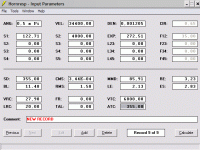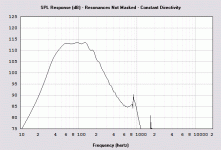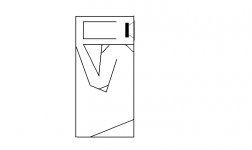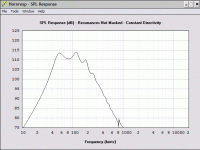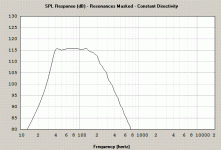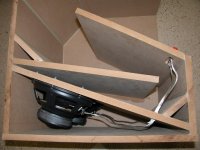I have a pair of JBL 10" GT1000 woofers that I would like to design a horn for. The horns would be used for music only so sound quality is important. I have a normal sized room and would like extension down in the 30's Hertz region. Would these be good woofers to do it?
Xmax 7.15 mm
Re 3.23 ohms
Le 2.13 mH
Sd 355 cm squared
Bl 11.48 TM
Vas 61.73 liters
Fs 28.64 Hertz
Qts 0.38
Qms 10.20
Qes 0.40
Pe 260 Wrms
SPL 94 dB
Z 4 ohm
I have built several boxes before, both sealed and bass reflex.
Xmax 7.15 mm
Re 3.23 ohms
Le 2.13 mH
Sd 355 cm squared
Bl 11.48 TM
Vas 61.73 liters
Fs 28.64 Hertz
Qts 0.38
Qms 10.20
Qes 0.40
Pe 260 Wrms
SPL 94 dB
Z 4 ohm
I have built several boxes before, both sealed and bass reflex.
Nichol1997 said:I have a pair of JBL 10" GT1000 woofers that I would like to design a horn for. The horns would be used for music only so sound quality is important. I have a normal sized room and would like extension down in the 30's Hertz region.
The horns will be vert large when you want them to go that low. Corner placement will be necessary to get reasonable enclosure dimensions.
Anyway, your woofers could go that low when horn-loaded. I quickly simulated a possible alignment (see attachment). I reduced the mouth area somewhat to keep the size down.
Attachments
Nichol1997 said:Wow, I did'nt realize it would have to be so big. Thank you for simulating it. Does HornResp also do folded horn designs? I think this might be a better option for me.
If the horn's still too large, you could reduce the mouth area some more. However, if you want 'flat' frequency response you should increase the horn's cutoff (higher F3), because a horn reproducing the 30 Hz region simply needs to be very large.
You could take the calculated values for throat area (St or S1), compression chamber volume (Vb or VRC), the length of the horn etc. as a starting point. Then you could design a folding pattern to fit the horn into a cabinet. It's important to maintain the horn's expansion through the bends.
Hi Eside,
you chose a 3:1 ratio for Sd:St. Why?
It seemed to result in very low ripple in the passband. Can I assume that is not coincidence?
For 30Hz you have chosen quite a short horn at 2.72m, resulting in -12db @30Hz. Is the bass roll more due to horn length or Vtc?
What is ATC?
Nichol,
just to give you a feel for some numbers expect a speaker volume of at least half a Labhorn (350litres) for mediocre performance and equal to Labhorn (700litres) for adequate performance, for good performance you may need Tannoy Westminster volume (1000litres). Corner loading can and should be used to reduce the Tannoy target. Corner loading will be mandatory for the 350L cabinet and advised for the 700L cabinet. The Labhorn needs 12cabinets in free space, 6cabinets in single boundary space and 3cabinets in 2 boundary space (floor and wall loading). 1.5cabinets are needed for corner loading but a mouth extender will reduce this requirement to 1cabinet.
Corner loading simulates a mouth area equal to 8times the actual mouth area and can approach 16times when the corner is used to continue the expansion of the actual horn flare.
you chose a 3:1 ratio for Sd:St. Why?
It seemed to result in very low ripple in the passband. Can I assume that is not coincidence?
For 30Hz you have chosen quite a short horn at 2.72m, resulting in -12db @30Hz. Is the bass roll more due to horn length or Vtc?
What is ATC?
Nichol,
just to give you a feel for some numbers expect a speaker volume of at least half a Labhorn (350litres) for mediocre performance and equal to Labhorn (700litres) for adequate performance, for good performance you may need Tannoy Westminster volume (1000litres). Corner loading can and should be used to reduce the Tannoy target. Corner loading will be mandatory for the 350L cabinet and advised for the 700L cabinet. The Labhorn needs 12cabinets in free space, 6cabinets in single boundary space and 3cabinets in 2 boundary space (floor and wall loading). 1.5cabinets are needed for corner loading but a mouth extender will reduce this requirement to 1cabinet.
Corner loading simulates a mouth area equal to 8times the actual mouth area and can approach 16times when the corner is used to continue the expansion of the actual horn flare.
Hi,
a thought just occured, below the horn loading passband the speaker sees a loading of just the rear chamber and starts to perform as a sealed box design at these low frequencies.
If your system could overload the driver in this situation of high drive voltage at below passband frequency then you need to add a high pass filter to protect the driver.
But you may be able to adjust the rear chamber resistance to give the protection you need but at the expense of raising the low frequency cut off frequency.
a thought just occured, below the horn loading passband the speaker sees a loading of just the rear chamber and starts to perform as a sealed box design at these low frequencies.
If your system could overload the driver in this situation of high drive voltage at below passband frequency then you need to add a high pass filter to protect the driver.
But you may be able to adjust the rear chamber resistance to give the protection you need but at the expense of raising the low frequency cut off frequency.
AndrewT said:Hi Eside,
you chose a 3:1 ratio for Sd:St. Why?
It seemed to result in very low ripple in the passband. Can I assume that is not coincidence?
For 30Hz you have chosen quite a short horn at 2.72m, resulting in -12db @30Hz. Is the bass roll more due to horn length or Vtc?
What is ATC?
I calculated the throat area with Keele's math, a CR of 3:1 should be low enough for the driver to work as intended (depending on the voltage level at which it will be driven).
Together with a throat chamber set to the horn's upper cutoff frequency (Fh, in this case 150 Hz), the FR becomes quite flat.
I chose 35 Hz as the lower cutoff frequency (Fl). The rear compresson chamber Vb was also set to this frequency.
ATC is the 'surface' of the throat chamber, in square cm.
Of course the design could be improved, it just was a quick simulation.
Hi Eside,
improved, I have never got a graph that was as ripple free.
I think I will need to ask you to simulate my proposal. What's your fee? I hope I'm just joking, quite a few members already recognise my mean streak and have even commented on it in the past.
BTW thanks for the reply.
Surface area of the throat chamber? What is that, obvoiusly not the throat area (St)? is it related to Sd? Which in turn is the area that must be reduced to give St.
improved, I have never got a graph that was as ripple free.
I think I will need to ask you to simulate my proposal. What's your fee? I hope I'm just joking, quite a few members already recognise my mean streak and have even commented on it in the past.
BTW thanks for the reply.
Surface area of the throat chamber? What is that, obvoiusly not the throat area (St)? is it related to Sd? Which in turn is the area that must be reduced to give St.
I found a design that I like on William Cowan's site, the "Horn Sub Jr."
http://diy.cowanaudio.com/
Will my JBL's model well in this enclosure? Can someone post the frequency response graph? I am thinking about doing the exact dimensions since he has calculated everything already.
http://diy.cowanaudio.com/
Will my JBL's model well in this enclosure? Can someone post the frequency response graph? I am thinking about doing the exact dimensions since he has calculated everything already.
Hi,
download hornresp, it's free.
Put in the same info and see the graph.
Then substitute your own speaker data and see if anything changes.
Now omit S4 which is a guesstimate for corner expansion for that last metre and see what the graph looks like.
Take care to read the whole of Cowan's page, there are many pertinent pointers to obtaining adequate performance from his junior horn.
download hornresp, it's free.
Put in the same info and see the graph.
Then substitute your own speaker data and see if anything changes.
Now omit S4 which is a guesstimate for corner expansion for that last metre and see what the graph looks like.
Take care to read the whole of Cowan's page, there are many pertinent pointers to obtaining adequate performance from his junior horn.
AndrewT said:
I think I will need to ask you to simulate my proposal. What's your fee? I hope I'm just joking, quite a few members already recognise my mean streak and have even commented on it in the past.
You're welcome! I'm not an expert, but I'd like to simulate some designs.
Nichol1997 said:I found a design that I like on William Cowan's site, the "Horn Sub Jr."
http://diy.cowanaudio.com/
Will my JBL's model well in this enclosure? Can someone post the frequency response graph? I am thinking about doing the exact dimensions since he has calculated everything already.
I simulated your driver in the Horn Sub JR, see attachment for frequency response. I think you want flatter response, so you may try other designs. Personally I like the folding pattern used in this horn...
Attachments
G'day Nichol1997
Your JBL drivers actually appear to work quite well in my little basshorn. The specs of your drivers are very similar to the Etone drivers I'm using. If you build this horn with your drivers and placed it firing into the corner of your room (Assuming a domestic sized room) you will obtain a flat response to a bit below 40Hz.
My inroom measured response is +/-3dB from 34Hz to above 100Hz. This is actually better than the horn simulates in hornresponse.
It is an easy horn to build, I see you have little to loose.
Cheers
William Cowan
Your JBL drivers actually appear to work quite well in my little basshorn. The specs of your drivers are very similar to the Etone drivers I'm using. If you build this horn with your drivers and placed it firing into the corner of your room (Assuming a domestic sized room) you will obtain a flat response to a bit below 40Hz.
My inroom measured response is +/-3dB from 34Hz to above 100Hz. This is actually better than the horn simulates in hornresponse.
It is an easy horn to build, I see you have little to loose.
Cheers
William Cowan
Attachments
Old post, but I thought I would give everyone an update. I finally got around to building them to Cowan's specifications. Well not exactly, the depth of my enclosure was half an inch less than Cowan's. This happened when I switched everything to English units and did not double check my work. Oh well. I have them hooked up in series to a Behringer EP2500 and I am quite pleased with the performance. Real clean and loud.
In fact, they are just as loud if not louder than my pair of Ascendant Audio Avalanche 18" drivers that are housed in a bass reflex enclosure tuned to 14 Hz.
I have not measured them with a SPL meter but I plan on doing so in a few weeks. I hope I don't have any peaks.
In fact, they are just as loud if not louder than my pair of Ascendant Audio Avalanche 18" drivers that are housed in a bass reflex enclosure tuned to 14 Hz.
I have not measured them with a SPL meter but I plan on doing so in a few weeks. I hope I don't have any peaks.
Attachments
- Status
- This old topic is closed. If you want to reopen this topic, contact a moderator using the "Report Post" button.
- Home
- Loudspeakers
- Subwoofers
- Need help designing a horn
